Water Lily
- February 9, 2024
- 0 comment
Explore the serene beauty of water lilies, their care, varieties, and role in aquatic gardens. Dive into the world of these enchanting blooms. Water lilies, with their graceful presence and diverse varieties, embody the essence of tranquility in aquatic gardens. These enchanting blooms not only captivate the senses with their delicate beauty but also play a crucial role in the health and balance of their watery ecosystems. In this comprehensive guide, we delve into the world of water lilies, exploring the intricacies of their care, the richness of their varieties, and the indispensable part they play in aquatic settings. Join us as we navigate through the serene and fascinating journey of nurturing these splendid flowers.
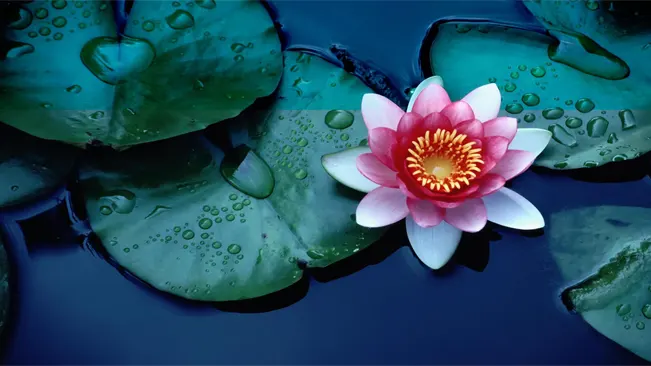
| Benefits | Description |
|---|---|
| Aesthetic Beauty | Water lilies enhance the visual appeal of ponds, lakes, and gardens with their exquisite flowers and floating leaves. |
| Cultural Symbolism | Water lilies hold cultural significance in various societies, symbolizing purity, rebirth, and enlightenment. |
| Ecological Role | Water lilies play a vital role in aquatic ecosystems by providing habitat, shelter, and nutrient absorption for aquatic organisms. |
| Oxygen Production | Through photosynthesis, water lilies release oxygen into the water, improving overall water quality and supporting aquatic life. |
| Water Quality Improvement | Water lilies help maintain water quality by absorbing excess nutrients, reducing algae growth, and stabilizing sediments. |
| Recreation and Relaxation | Water gardens featuring water lilies provide tranquil spaces for recreation, relaxation, and contemplation, benefiting human well-being. |
| Medicinal and Therapeutic Properties | Some parts of the water lily plant are used in traditional medicine for their potential medicinal properties, including wound healing and pain relief. |
| Economic Value | Water lilies contribute to the economy through horticultural trade, tourism associated with water gardens, and potential pharmaceutical applications. |
A Botanical Marvel
Water lilies belong to the family Nymphaeaceae and encompass various species found in freshwater habitats around the globe. These exquisite aquatic plants are renowned for their distinct circular leaves, often referred to as lily pads, which float effortlessly on the water’s surface. The leaves are equipped with a unique adaptation, a waxy coating that repels water, ensuring they remain buoyant and unblemished.
At the heart of the water lily’s charm lies its captivating flowers. Delicately cupped and adorned with layers of silky petals, these blossoms emerge from the depths of the water, rising above the surface on sturdy stems. The flowers’ hues span a spectrum of whites, pinks, yellows, and purples, each exuding its own enchanting aura.
Different Variety of Water Lily
European White Water Lily (Nymphaea alba)
This native European species features large, fragrant white flowers with yellow centers and round green leaves. It is often found in slow-moving freshwater habitats.

Fragrant Water Lily (Nymphaea odorata)
Native to North America, this species is known for its fragrant white or pink flowers and circular lily pads. It thrives in shallow waters of ponds, lakes, and slow streams.

Blue Lotus or Blue Water Lily (Nymphaea caerulea)
Native to Egypt and other parts of Africa, this species has striking blue or blue-purple flowers and blue-green leaves. It holds cultural significance in ancient Egyptian mythology and is often depicted in art and symbolism.

Nymphaea ‘Attraction’
A hybrid cultivar, ‘Attraction’ features vibrant red flowers with yellow centers. It is a popular choice for water gardens and adds a bold splash of color to ponds and water features.

Nymphaea ‘James Brydon’
Another hybrid cultivar, ‘James Brydon’ produces deep red or crimson flowers with green pads. It is prized for its rich color and striking appearance.
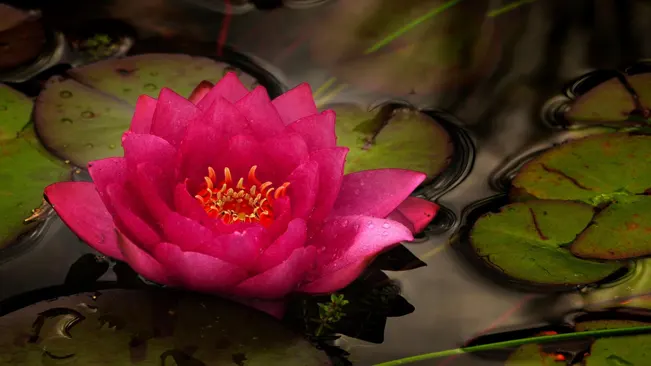
Nymphaea ‘Marliacea Chromatella’: This hybrid cultivar boasts fragrant, cup-shaped yellow flowers that gradually fade to a creamy white. Its green pads provide a beautiful contrast to the bright blooms.
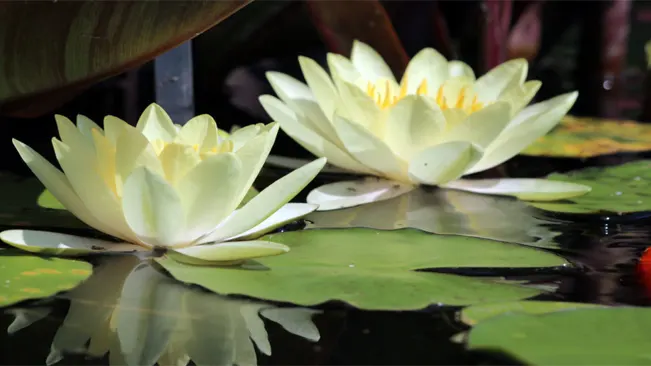
Nymphaea ‘Perry’s Orange Sunset’
With its unique blend of orange and peach hues, ‘Perry’s Orange Sunset’ is a standout cultivar in water gardens. Its flowers feature a captivating sunset-like gradient, making it a focal point of attention.
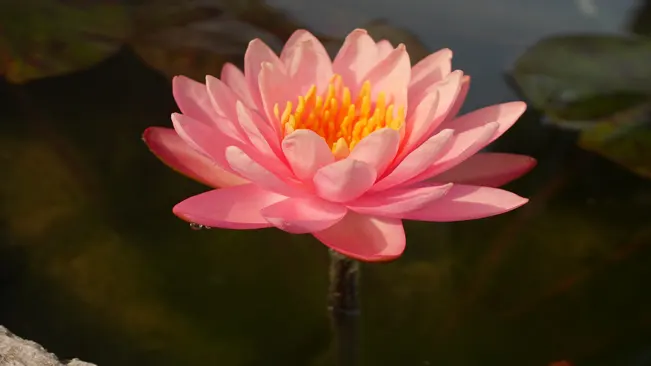
Nymphaea ‘Stargazer’
This cultivar is prized for its stunning star-shaped flowers, which range in color from pink to purple. Its unique blossom shape adds a touch of whimsy to ponds and water features.

Distinctive Features of Water Lily
Water lilies possess several distinctive features that set them apart from other aquatic plants. These features contribute to their unique appearance, ecological adaptations, and cultural significance. Here are some of the key distinctive features of water lilies:
Floating Leaves (Lily Pads)
One of the most recognizable features of water lilies is their large, round or oval-shaped leaves, commonly referred to as lily pads. These leaves float on the surface of the water and are supported by long stalks or petioles. Lily pads have a waxy coating that repels water, allowing them to remain buoyant and maintain their structure.
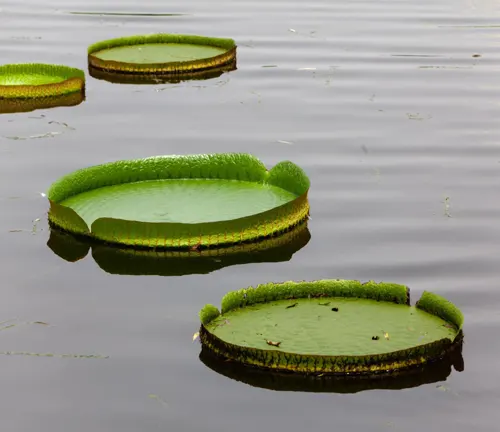
Showy Flowers
Water lilies produce large, showy flowers that float on the water’s surface or emerge slightly above it on sturdy stems. The flowers typically have multiple petals arranged in a circular or star-like pattern, with a central receptacle containing reproductive structures such as stamens and pistils. Water lily flowers come in a variety of colors, including white, pink, yellow, red, and blue, adding to their visual appeal.

Submerged Roots and Rhizomes
Beneath the water’s surface, water lilies have submerged roots and rhizomes, which anchor the plants in the substrate and absorb water and nutrients. The roots are often long, fibrous structures that extend downward from the base of the plant, while the rhizomes are horizontal, underground stems that give rise to new shoots and leaves.
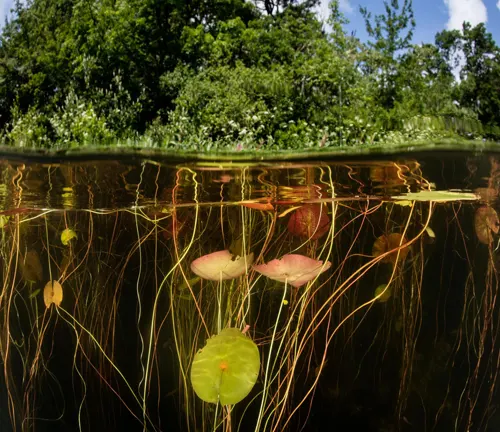
Adaptations for Aquatic Life
Water lilies are well-adapted to their aquatic habitat, possessing specialized structures and physiological adaptations that enable them to thrive in water. For example, their floating leaves have air-filled spaces that provide buoyancy, while their submerged roots and rhizomes absorb nutrients from the water and anchor the plants in place.
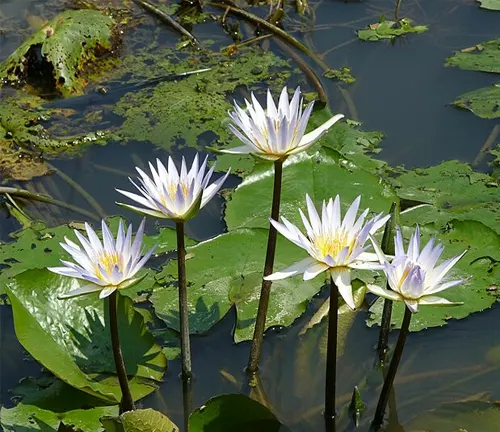
Fragrant Flowers (in Some Species)
While not all water lilies have fragrant flowers, certain species and cultivars produce blooms with a pleasant fragrance. The fragrance of water lily flowers can vary depending on the specific variety, ranging from sweet and floral to subtle and delicate.

Cultural and Symbolic Significance
Water lilies hold cultural and symbolic significance in various cultures and religions around the world. They are often associated with themes such as purity, enlightenment, rebirth, and spiritual growth, and feature prominently in art, literature, and mythology.

These distinctive features contribute to the beauty, ecological importance, and cultural significance of water lilies, making them beloved symbols of tranquility and grace in aquatic environments.
Cultural Significance
Water lilies have been significant symbols in various cultures throughout history. In ancient Egypt, they symbolized rebirth and regeneration, particularly the blue lotus native to the Nile, which was associated with the sun’s cycle and life and death. In Asian religions like Buddhism and Hinduism, the water lily, or lotus, signifies purity and the path to enlightenment, representing the rise from murky waters to bloom immaculately. Besides their symbolic importance, water lilies play a crucial ecological role, providing habitat and shelter for various aquatic species with their floating leaves.
Habitat Creation
Water lilies provide essential habitat for a diverse range of aquatic organisms. The floating leaves, known as lily pads, create shady spots and refuge for fish, amphibians, and other aquatic animals seeking protection from predators or harsh sunlight. These leaves also serve as resting platforms for turtles, dragonflies, and other creatures.
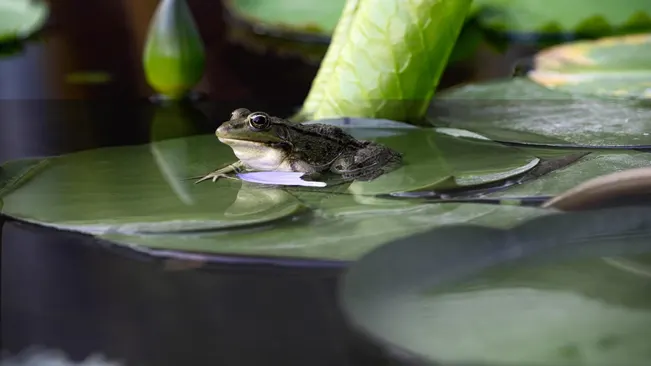
Shelter for Invertebrates
The submerged roots of water lilies offer a hospitable environment for invertebrates such as snails, worms, and insect larvae. These organisms utilize the roots as anchorage points, shelter, and breeding sites, contributing to the overall biodiversity of the aquatic habitat.
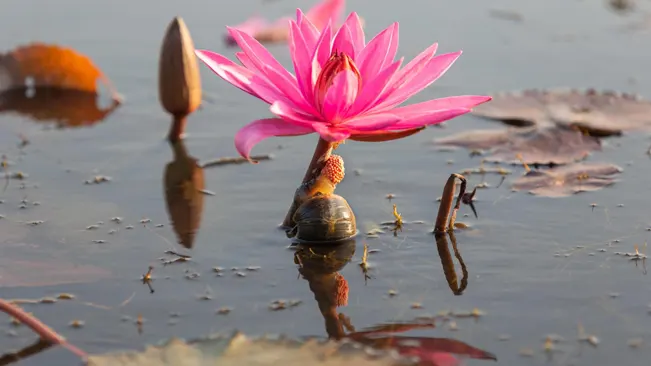
Microbial Communities
Beneath the surface, water lily roots host diverse communities of microorganisms, including bacteria and fungi. These microorganisms play vital roles in nutrient cycling, decomposition, and the breakdown of organic matter, helping to maintain water quality and ecosystem function.

Nutrient Absorption
Water lilies are efficient at absorbing nutrients from the water, including nitrogen and phosphorus. Excess nutrients, often resulting from agricultural runoff or wastewater discharge, can lead to eutrophication—a process that causes excessive algae growth, reduced oxygen levels, and degraded water quality. By absorbing these nutrients, water lilies help mitigate eutrophication and maintain a healthy balance in aquatic ecosystems
Oxygen Production
Like all plants, water lilies undergo photosynthesis, a process by which they utilize sunlight to convert carbon dioxide and water into oxygen and carbohydrates. This photosynthetic activity results in the release of oxygen into the water, benefiting aquatic organisms such as fish and other aquatic animals that rely on dissolved oxygen for respiration.
Stabilization of Sediments
The roots of water lilies help stabilize sediments on the bottom of ponds, lakes, and rivers, reducing erosion and preventing the loss of valuable habitat. By anchoring themselves firmly in the substrate, water lilies contribute to the structural integrity of aquatic ecosystems and help maintain water clarity by minimizing sediment disturbance.
Ecological Role and Gardens of Tranquility
Beyond its cultural significance, the water lily plays a vital ecological role in aquatic ecosystems. Its floating leaves provide shade and shelter for fish, amphibians, and other aquatic organisms, while its submerged roots offer habitats for invertebrates and microorganisms. Additionally, water lilies help maintain water quality by absorbing excess nutrients and providing oxygen through photosynthesis.
In the realm of horticulture, water lilies have found a cherished place in gardens and landscapes worldwide. Water gardens, designed to mimic natural aquatic habitats, often feature water lilies as focal points, creating serene and enchanting vistas. Cultivars with varying sizes, colors, and bloom times allow gardeners to tailor their aquatic displays to suit their preferences and surroundings.
Conservation Challenges
Despite their enduring appeal, water lilies face threats from habitat loss, pollution, and invasive species. Wetland degradation and urbanization pose significant challenges to their survival, disrupting the delicate balance of freshwater ecosystems. Conservation efforts, including habitat restoration, pollution mitigation, and invasive species management, are essential to safeguarding these emblematic plants for future generations to admire and cherish.
- Habitat Loss: One of the most significant threats to water lilies is habitat loss due to factors such as urbanization, agricultural expansion, and infrastructure development. Wetlands, ponds, and other freshwater habitats where water lilies thrive are often drained, filled in, or altered for human use, depriving these plants of essential habitat.
- Pollution: Pollution from various sources, including agricultural runoff, industrial discharge, and urban stormwater runoff, poses a significant threat to water lilies and their freshwater ecosystems. Excessive nutrients such as nitrogen and phosphorus from fertilizers can lead to algal blooms, which can shade out water lilies and deplete oxygen levels in the water, negatively impacting their growth and survival.
- Invasive Species: Invasive aquatic plants and animals, introduced intentionally or unintentionally, can outcompete native water lilies for resources, disrupt their habitats, and alter ecosystem dynamics. Invasive plants like water hyacinth (Eichhornia crassipes) and Eurasian watermilfoil (Myriophyllum spicatum) can form dense mats that smother water lilies and other native vegetation, reducing biodiversity and degrading habitat quality.
- Climate Change: Climate change poses indirect threats to water lilies by altering temperature regimes, precipitation patterns, and hydrological cycles. Changes in water temperature and availability can affect the timing of flowering, growth rates, and overall reproductive success of water lilies. Additionally, extreme weather events such as droughts, floods, and storms can cause habitat destruction and disrupt water lily populations.
To address these conservation challenges and protect water lilies and their freshwater habitats, concerted efforts are needed:
- Habitat Restoration: Restoring and conserving natural wetlands, ponds, and other freshwater habitats is crucial for maintaining healthy populations of water lilies and supporting overall ecosystem health. This may involve reestablishing native vegetation, controlling invasive species, and implementing sustainable land management practices.
- Pollution Mitigation: Implementing measures to reduce nutrient runoff, sedimentation, and chemical pollution from agricultural, industrial, and urban sources can help improve water quality and mitigate the negative impacts of pollution on water lilies and their habitats.
- Invasive Species Management: Managing and controlling invasive aquatic plants and animals through methods such as mechanical removal, herbicide application, biological control, and prevention measures can help prevent the spread of invasives and protect native water lilies and biodiversity.
- Education and Outreach: Increasing public awareness about the importance of water lilies and freshwater ecosystems, as well as the threats they face, can foster stewardship and support conservation efforts. Engaging communities, stakeholders, and policymakers in conservation initiatives is essential for long-term success.
Conclusion
In the tapestry of nature, the water lily emerges as a symbol of grace, resilience, and tranquility. From ancient myths to modern gardens, its timeless beauty continues to captivate hearts and minds, reminding us of the interconnectedness of all living beings and the importance of preserving our natural world. As we gaze upon the delicate petals adrift on still waters, may we find solace in the profound simplicity of nature’s wonders, and may the enchanting allure of the water lily inspire us to nurture and protect the fragile ecosystems that sustain us all.
FAQs (Frequently Asked Questions)
- What are water lilies?
Water lilies are aquatic plants belonging to the family Nymphaeaceae. They are characterized by their floating leaves (lily pads) and showy flowers, which typically float on the surface of freshwater habitats. - Where are water lilies found?
Water lilies are found in freshwater habitats around the world, including ponds, lakes, slow-moving rivers, and marshes. They thrive in calm, shallow waters with plenty of sunlight. - How do water lilies reproduce?
Water lilies reproduce both sexually and asexually. Sexual reproduction occurs through pollination, where insects or wind transfer pollen between flowers. Asexual reproduction occurs through the growth of rhizomes (underground stems) that send up new shoots and leaves. - What is the significance of water lilies in different cultures?
Water lilies hold cultural significance in various societies. In ancient Egypt, they symbolized rebirth and were associated with the sun god Ra. In Asian cultures like Buddhism and Hinduism, they represent purity, enlightenment, and spiritual growth. - Do all water lilies have fragrant flowers?
No, not all water lilies have fragrant flowers. While some species and cultivars produce flowers with a pleasant fragrance, others may have no discernible scent. Fragrance varies depending on the specific variety. - How deep do water lilies grow?
Water lilies typically grow in water depths ranging from a few inches to several feet, depending on the species and cultivar. Some varieties prefer shallow water, while others can thrive in deeper sections of ponds or lakes. - Do water lilies require special care?
Water lilies are relatively low-maintenance plants, but they do have specific care requirements. They need plenty of sunlight to bloom and thrive, and their roots should be planted in a rich, loamy substrate. Regular fertilization and occasional division of rhizomes help promote healthy growth. - Can water lilies grow in containers or small ponds?
Yes, water lilies can be grown in containers or small ponds, provided they have enough space to spread their roots and receive adequate sunlight. Dwarf or miniature varieties are especially well-suited for container gardening. - Are water lilies invasive?
Some species of water lilies can become invasive if not properly managed. They have the potential to spread rapidly and outcompete native aquatic plants, disrupting ecosystems. It’s important to research and choose non-invasive species or cultivars for planting in natural water bodies. - How long do water lilies bloom?
The blooming period of water lilies varies depending on the species, cultivar, and environmental conditions. Generally, individual flowers bloom for several days to a week before wilting, but water lilies can produce blooms continuously throughout the growing season under optimal conditions.





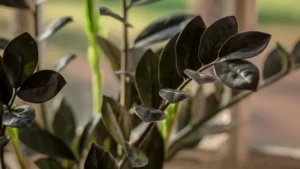
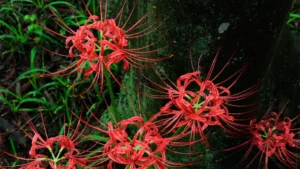
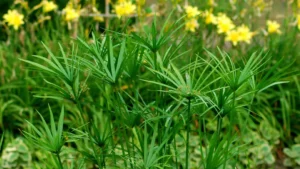


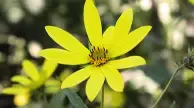



Leave your comment